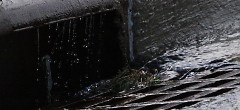
Large volume of stormwater traveling untreated to a drain that probably leads directly to a river or lake. /inhabitat.com
This dispatch was added by one of our Nonprofit Neighbors. It does not represent the editorial voice of The Rapidian or Community Media Center.

Large volume of stormwater traveling untreated to a drain that probably leads directly to a river or lake. /inhabitat.com
September is historically Grand Rapids’ rainiest month, with an average of 0.14 inches per day and 4.2 inches per month since 1986. This week also marks the 25th anniversary of Grand Rapids’ rainiest month ever and one of the state’s deadliest rainstorms, when the “100 year flood” claimed 10 lives and a half billion dollars in property damage on September 9 to 12, 1986.
Severe storms and heavy persistent rains that year caused as much as 13 inches of extra water. Twenty-two counties were confirmed as disaster areas following the flood. Rising lake and river levels were exacerbated when several dams burst, as they were not able to hold the excess pressure. Signs boasting “Waterfront Property” appeared on flooded properties of those who still had a sense of humor.
September continues to produce large amounts of rain for our region; our focus turns to the final destination of the water resulting from severe autumn storms as well as the contaminants it picks up along the way.
As such, this is a great time to discuss how the community addresses the constant threat stormwater poses to human and environmental health. Not only is flooding still a very real threat, stormwater is also the largest source of water pollution in West Michigan. In Grand Rapids, it takes just 15 to 30 minutes for stormwater to reach the Grand River, carrying with it a devil’s brew of pollutants and particulates. Anyone who has flown over the mouth of the Grand River in Grand Haven has seen this effect first hand, as the brown plume of sediment and pollution is plainly visible overhead.
Stormwater management is WMEAC’s signature water issue and the focus of our new 15 To The River campaign. As the summer sun fades into autumn rain this month, take a moment to think about the stormwater running over rooftops, fertilized lawns, engine oil-stained parking lots and city streets. Think about what contaminants it will pick up on its journey to the Great Lakes waterways. Invest in a rain barrel, be drain-friendly, support green infrastructure, help plant a rain garden and do your part to protect our water resources.
For more information, please visit 15toriver.org.
The Rapidian, a program of the 501(c)3 nonprofit Community Media Center, relies on the community’s support to help cover the cost of training reporters and publishing content.
We need your help.
If each of our readers and content creators who values this community platform help support its creation and maintenance, The Rapidian can continue to educate and facilitate a conversation around issues for years to come.
Please support The Rapidian and make a contribution today.